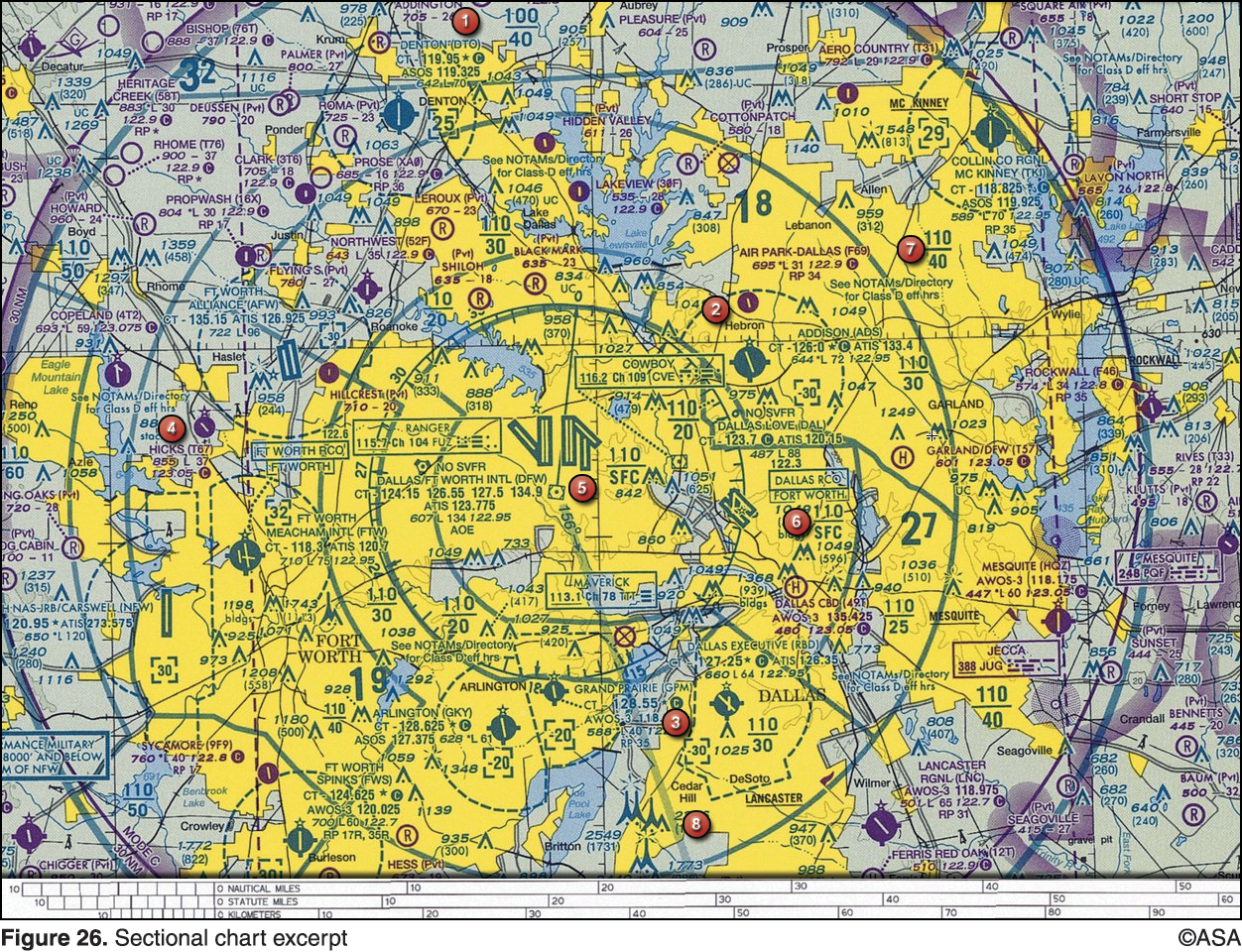This week we are going to look at a few questions as they relate to enroute flight, specifically questions that require the use of an E6B. Enroute flight is a popular topic on the FAA knowledge exam and these questions may be very similar to the ones you encounter on your knowledge test. The first question involves determining a magnetic heading using our E6B Flight Computer.
(Refer to Figure 26.) Determine the magnetic heading for a flight from Fort Worth Meacham (area 4) to Denton Muni (area 1). The wind is from 330° at 25 knots, the true airspeed is 110 knots, and the magnetic variation is 7° east.

Let’s break this question down into four simple steps.
- Plot a course from Meacham to Denton, and determine the course heading using a plotter. I get 021°.
- Next, using the wind given in the question (330 @ 25) , calculate a correction angle using the E6B. This angle will be the difference between the course bearing and the heading required to maintain that course. I’ve computed a correction angle of 10° to the left.
- Remember a left correction angle is subtracted from the course to obtain a true heading. 021° (course from step 1) – 010° (wind correction from step 2) = 011° (true heading)
- Lastly find the magnetic heading by adding or subtracting the variation given in the question (7° east) to the true heading. Remember subtract east and add west. 011 – 7 = 004° (magnetic heading)
Your answer to the question would be 004°. Next.
How far will an aircraft travel in 2-1/2 minutes with a groundspeed of 98 knots?
To find the distance flown in a given time, multiply ground speed by time. The distance flown in 2-1/2 minutes (convert to hours by dividing by 60) at a ground speed of 98 knots is .04 x 98 = 4.08 NM.
Or…
Using our E6B we would take our rate indicator of 60 on the inner scale and line it up with 98 on the outer scale. The inner scale shows time, so we would locate 25 (2.5 minutes) and on the outer scale read 40.8 interpreting that as 4.08 NM.
This next question requires us to sort of work in a backwards direction to find the correct answer.
If a true heading of 135° results in a ground track of 130° and a true airspeed of 135 knots results in a groundspeed of 140 knots, the wind would be from?
So a 135° means we are flying in a southeast direction and if this true heading is resulting in a ground tack of 130° the wind would have to be coming from somewhere off our right wing pushing the aircraft to the left. In addition, we know that the wind is also resulting in an increase of groundspeed so the wind is somewhere behind us. Using these two key pieces of information we can determine the wind must be from the southwest.
Using the wind side of the E6B we will line our true Index up with our true course of 135° with the grommet located at 135 on the center vertical line to account for the true airspeed. From there we have determined that the wind is coming from southwest so looking between the S and W find on the vertical line the 5° and count vertically down 5 to account for the 5 knot increase in speed. Draw a line from that point back to the grommet and rotate the circle until the line appears under the true index. On the inner circle read your wind direction of 246° and counting up from the grommet to the end of the line your wind speed of 13. Your wind is coming from 246 @ 13 knots.
See, its really not all that hard if you break the questions down into smaller chunks. Try one on your own and leave the answer in the comments section below, I will let you know if the answer is correct.
(Refer to Figure 26.) Determine the magnetic heading for a flight from Dallas Executive (area 3) to Fort Worth Meacham (area 4). The wind is from 030° at 10 knots, the true airspeed is 135 knots, and the magnetic variation is 7° east.




